Iapetus

Iapetus from Cassini, 2004. This mosaic image was obtained with the spacecraft's narrow angle camera on 31 December 2004, at a distance of about 172,400 kilometers (107,124 miles) from the moon and at a Sun-Iapetus-spacecraft, or phase, angle of 50 degrees. The image scale is 1 kilometer (0.6 mile) per pixel. The image has been contrast enhanced to aid visibility of surface features.
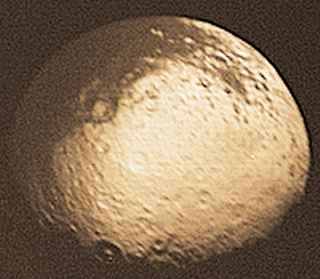
Iapetus from Voyager 2, on 22 August 1981.
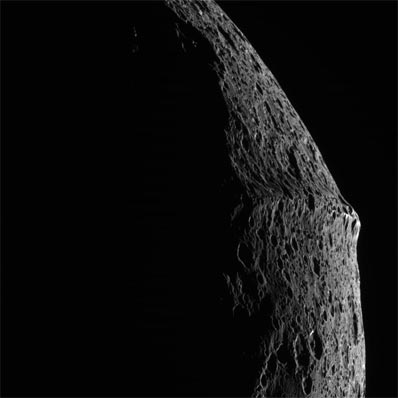
The great ridge on Iapetus seen in profile.
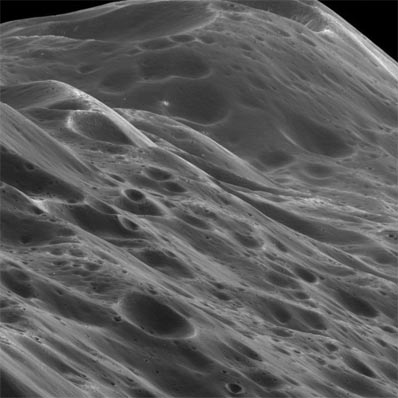
Mountainous terrain that reaches about 10 kilometers (6 miles) high along the unique equatorial ridge of Iapetus. Above the middle of the image can be seen a place where an impact has exposed the bright ice beneath the dark overlying material. The image was taken on 10 September 2007, with Cassini's narrow-angle camera at a distance of approximately 3,870 kilometers (2,400 miles) from Iapetus. Image scale is 23 meters (75 feet) per pixel.
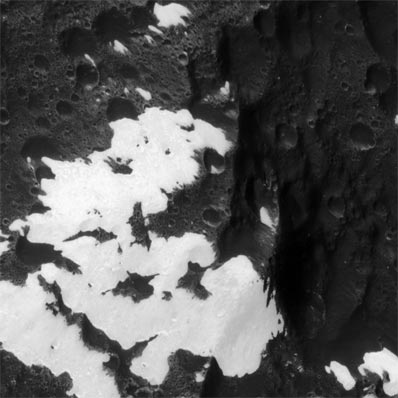
Cassini close-up of the patchy, bright and dark mountains originally identified in images from Voyager taken more than 25 years earlier. The terrain seen here is located on the equator of Iapetus at approximately 199° west longitude, in the transition region between the moon's bright and dark hemispheres. North is up. The image was taken on 10 September 2007, with Cassini's narrow-angle camera at a distance of approximately 9,240 kilometers (5,740 miles) from Iapetus. Image scale is 55 meters (180 feet) per pixel.
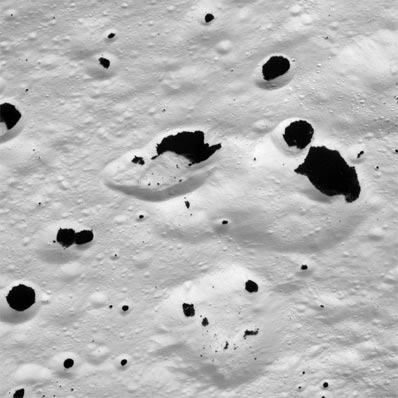
Dark material splatters the walls and floors of craters in the surreal, frozen wastelands of Iapetus. This image shows terrain in the transition region between the moon's dark leading hemisphere and its bright trailing hemisphere. The image was taken on 10 September 2007, with Cassini's narrow-angle camera at a distance of approximately 6,030 kilometers (3,750 miles) from Iapetus. Image scale is 36 meters (118 feet) per pixel.
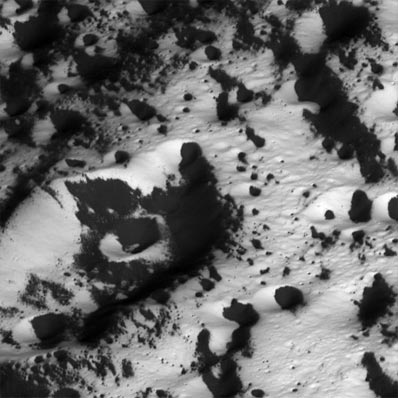
Cassini surveys a bright landscape coated by dark material on Iapetus. This image shows terrain in the transition region between the moon's dark leading hemisphere and its bright trailing hemisphere. The image was taken on 10 September 2007, with Cassini's narrow-angle camera at a distance of approximately 5,260 kilometers (3,270 miles) from Iapetus. Image scale is 32 meters (105 feet) per pixel.
Iapetus is an outer moon of Saturn, also known as Saturn VII, that was discovered by Giovanni Cassini in 1671. It is remarkable in that its brightness changes by a factor of seven as it moves around its orbit – a feature that has led to it being called the "yin and yang" moon. Whereas the leading hemisphere of Iapetus is as dark as asphalt with a slight reddish color, the trailing hemisphere is very bright.
| discovery | 1671, by Giovanni Cassini |
| semimajor axis | 3,560,820 km (2,213,060 mi) |
| diameter | 1494 × 1498 × 1425 km (929 × 931 × 886 mi) |
| mean density | 1.27 g/cm3 |
| escape velocity | 0.61 km/s (2196 km/h, 1365 mph) |
| orbital period | 79.33 days (79 d 8 h) |
| orbital eccentricity | 0.029 |
| orbital inclination | 15.47° |
| axial period | synchronous |
| visual albedo | 0.04 to 0.5 |
Great ridge
In December 2004, the Cassini spacecraft discovered a further extraordinary feature of Iapetus: a topographic ridge that coincides almost exactly with the geographic equator. The ridge is conspicuous in the top image on this page as an approximately 20-kilometer (12-mile) wide band that extends from the western (left) side of the disk almost to the day/night boundary on the right. On the left horizon, the peak of the ridge reaches at least 13 kilometers (8 miles) above the surrounding terrain. Along the roughly 1,300-kilometer (800-mile) length over which it can be traced in this image, it remains almost exactly parallel to the equator within a couple of degrees. The physical origin of the ridge has yet to be explained. It is not yet clear whether the ridge is a mountain belt that has folded upward, or an extensional crack in the surface through which material from inside Iapetus erupted onto the surface and accumulated locally, forming the ridge.
Giant landslides
Iapetus is also the site of unusual landslides, seen only rarely elsewhere in the solar system, on Earth and Mars. These landslides, called sturzstroms or "long-runout landslides", involve debris traveling up to 30 times further horizontally than it does vertically. Their origin is still not known for sure, but, according to an analysis of Cassini observations of sturzstroms on Iapetus by a team of planetary geologists, published in 2012, flash heating of icy rubble is likely a key ingredient.[1] When such a landslide begins it heats the contact points between fragments of ice debris, melting them and leading to a very low coefficient of friction; this enables the falling material to travel out very far from the initial site of the fall, as if it is running on virtually frictionless rollers.
Light and dark regions
The scene in the top image is dominated by the dark, heavily-cratered region, called Cassini Regio, that covers nearly an entire hemisphere of Iapetus. The view is centered on the moon's equator and on roughly 90° west longitude – a location that always faces the direction of Iapetus's orbital motion around Saturn. Within Cassini Regio, and especially near the equator, dark deposits with a visual reflectivity of only about 4% coat nearly everything with remarkable uniformity. However, at latitudes of about 40°, the surface transitions to a much brighter, icy terrain near the pole where the brightest icy materials have reflectivity over 60%. However, this region is not uniform: Close inspection reveals that the surface is stained by crudely north-south trending wispy streaks of darker material, typically a few km wide and sometimes tens of km long. An ancient, 400-kilometer (250-mile) wide impact basin appears just above the center of the disk. The basin is heavily overprinted by more recent, smaller impact craters. The basin rim is delineated by steep scarps that descend to the basin floor. Many of these scarps, as well as walls of nearby craters, appear bright, probably due to exposed outcrops of relatively clean ice. Particularly at mid-latitudes, the brightest scarp exposures appear to face away from the equator (i.e. toward the pole). Often, the opposite south-facing scarps are stained with the lower-brightness material.
The origin of Cassini Regio is a long-standing debate among scientists. According to one theory, the dark material may have erupted onto Iapetus's icy surface from the interior. Another theory holds that the dark coating consists of debris that was ejected by impact events on dark, outer satellites of Saturn, such as Phoebe, and then swept up by Iapetus as it moved in its orbit. Details of this Cassini image mosaic do not definitively rule out either of the theories. However, they do provide important new insights and constraints.
The uniform appearance of the dark materials at the equator, the apparent thinning and spottiness of the dark materials at progressively higher latitudes and dark wispy streaks near the distal margin of Cassini Regio strongly suggest that dark material was emplaced as a coating. One of the important new results is that no clear evidence can be found that erupted fluids have resurfaced Cassini Regio. The high density of impact craters argues that the terrain underlying the dark coating is relatively ancient and has not been eradicated by its emplacement. Thus, Cassini Regio may have had its origin in plume-style eruptions in which dark particulate materials accumulated on the surface as fallout, perhaps in conjunction with the creation of the equatorial ridge. On the other hand, the dark deposits in Cassini Regio may be a surface coating consistent with, and perhaps more simply explained by, the fall of dark materials from outside.
This latter idea received a powerful boost in 2009 with the discovery of a colossal, infrared-emitting ring around Saturn, the material of which appears to have come from Phoebe. It now seems likely that the dark material on the surface of Iapetus consists of debris swept up from this previously unknown ring.
Far-out speculation
The extreme albedo range displayed by Iapetus had earlier prompted the suggestion that the brightness variations might be artificial. For example, Donald Goldsmith and Tobias Owen in The Search for Life in the Universe 2 (1980) wrote:
This unusual moon is the only object in the Solar System which we might seriously regard as an alien signpost - a natural object deliberately modified by an advanced civilization to attract our attention ...
By coincidence, Iapetus is the site of the "Star Gate" in Arthur C. Clarke's 2001: A Space Odyssey.3
Cassini close flyby of 2007
On 10 September 2007, Cassini flew past Iapetus at a distance from the surface of only 1,640 kilometers (1,000 miles) – almost 100 times closer than the 2004 flyby. It sent back startling images, some of which are shown below, that promise to revolutionize our knowledge of this strange moon.
References
1. Singer, K. N., McKinnon, W. B., Schenk, P. M. "Massive
ice avalanches on Iapetus mobilized by friction reduction during flash
heating." Nature Geoscience, doi:10.1038/ngeo1526. Published
online 29 July 2012.
2. Goldsmith, Donald, and Owen, Tobias. The Search for Life in the
Universe. Menlo Park, Calif.: Benjamin/Cummings (1980).
3, Clarke, Arthur C. 2001: A Space Odyssey. New York: New American
Library (1968).


